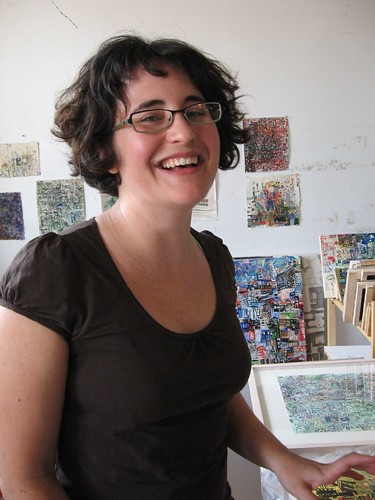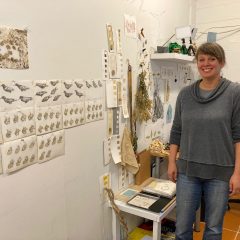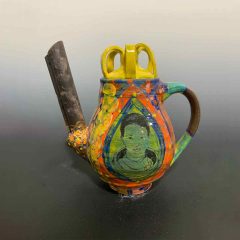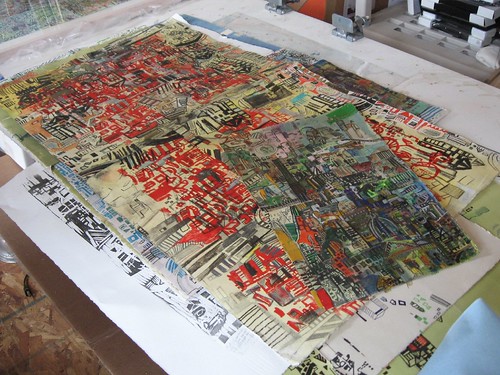
Works in progress by Miriam Singer
As works on paper go, Philly artist Miriam Singer‘s work–talismanic cityscape-maps that record time and place and daily life in layers–is not so much on paper as of paper. And that makes these combination prints/drawings a good fit with all the paper cutting and 3-D paper work that’s been filling the galleries lately (see post).
I paid her a studio visit a earlier this month, and learned she will be in The Rolling Canvas Art Collective, an exhibit and art auction at MBN August 1, of bike-related art presented by Fuji Bikes, Jinxed and R.E.Load. Also among the 20-plus participating artists are Adam Wallacavage, Ben Woodward, and Leanne Biank.
Singer’s studio is in the same building that houses Vox and Copy and the Khmer Art Gallery. It’s a section of a large factory loft space she shares with others, including Ryan Beck, who just had an exhibit at 222 Gallery.
I asked Singer about her education–she attended a post-bac at Brandeis (“It was awesome!”), Massachusetts College of Art (MFA), Yale, Brandeis (BA) and RISD. [Oops, not Yale and RISD–see comment at the end of the post from Miriam–Libby].
Singer added how her passion for cities and planning brought her to Harvard’s School of Urban Design, where they told her, “‘You should just stick to painting.'”
L. What about cities that interests you?
M. The density, warehouses, the gritty quality. I got really frustrated with Boston looking so cleaned up. I like a dense landscape. I live in the Intalian Market area. I like the mish mash of things. I think it’s also multiple histories in the raw.
I went from painting landscapes, and I started thinking about impressionism and light. I’d been thinking about my family. My mother died of cancer. I was 23, and felt I’d made enough work about it.
There’s so much subject matter in there–the mix of cities and my imagination, just interpreting what I’m seeing and still being intuitive.
I think a lot about Matisse. I’m definitely into his cutouts. I was doing a construction site about Buffalo, with different cutouts and photocopies.
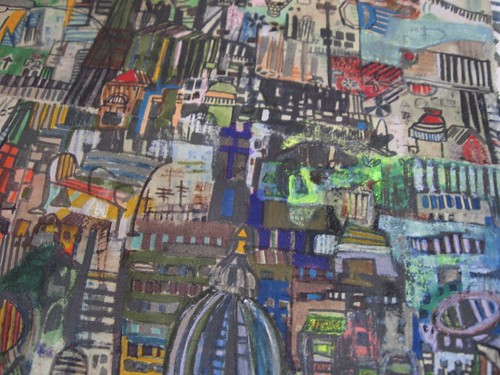
detail of a piece by Miriam Singer
L. How does that relate to the drawings?
M. The drawings I usually think of them as collages. Ideally, I like to build and build and build to make it seem like a collage. It’s a bunch of memories being together on one piece of paper.
L. When I look at your work, I think about how the pieces are records of time.
M. That’s hard to talk about. I do think about them growing over time. I pretty much work slowly on all my stuff. I pick it up later and I work in layers. You see the mark making, the erasures. There’s an anxiety in the stuff. …There’s an element of overworking.

Miriam Singer, several works, some in progress, piled up
L. How do you know when you’re done?
M. I take it home to my apapertment and spend some time with them, photograph them. When I photograph them, then they are done.
Paper really stops me. Paintings are neverending (quests for perfection). But with paper, I let things go, more. When they are finished, I react with it in a different way.
My drawings come from sketchbook-making. I constantly carried around a sketchbook. But then I started carrying around pieces of paper. They are diary like and came out of not having a studio any more. (Now I have one, but then I didn’t). It was tough making the transition (from school to working). That’s why I started to make these. I also wanted to focus on one drawing at a time. So I carry just one drawing in my bag. And I just need to draw a lot in general.
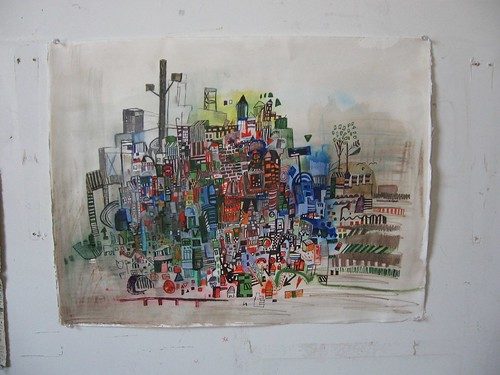
L. How do you describe the drawings?
M. It’s a chaotic landscape that I’m always trying to reproduce. It’s the feeling of stress, running around; it’s not peaceful. I’m always trying to pursue peace.
I have been making the same paintings over and over again for the past 10 years, recycling the same images. They’re never finished–[they] can be broken up. If they are broken up, I then concentrate on the small segment and finish it. I do need a huge amount of time to process it.
L. I notice how casual you are in how you handle the paper. [Singer tosses the work around, puts framed images on top of them just treats them like a notebook.]
M. I think they would make great rugs. Just kidding. Only just recently I stopped making them into postcards. Maybe I undervalue them. Each one is very specifiic. I can’t make them again. So why am I not taking care of them more?
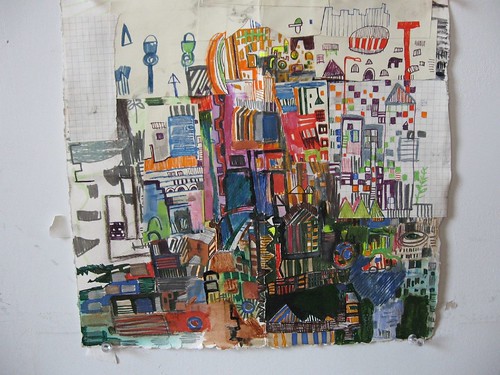
Miriam Singer, work with collaged elements added
L. OK, so why?
M. I like to abuse them. In that way it’s also a kind of a mark. If I spilled something on it, I work that spilled moment into them. Sometimes I dunk them in water so the color bleeds together. I’m not interested in aging it, but I am kind of interested in making it look like a Pirate’s map.
L. How do you make I living?
M. I helped paint murals with Shira Walinsky. I like the process of collaborating and making it on the wall. I like how physical they are. I also teach for Mural Arts for the Corps program, working with high school students. I’m not teaching this summer.
I’m a printing technician at Moore College. They won’t let me teach there because I’m staff.
L. What kinds of prints do you use in your drawings?
M. Wood blocks, etchings, silk screen, lithographs, monoprints.
L. Other materials?
M. pencil–Prismacolor, markers, crayons, graphite, acrylic–I add that at the end occasionally.



